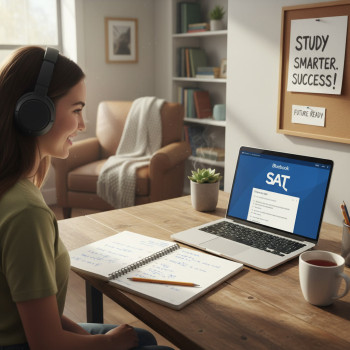Understanding OU’s SAT Position: What Today’s Applicants Need to Know
If the University of Oklahoma (OU) is on your college list, you’re probably wondering how the Digital SAT fits into the admissions picture. Short answer: OU reports a middle 50% SAT range for admitted students, considers SAT scores if you submit them, and operates with a flexible approach that emphasizes the whole application. But the full story matters — especially when you’re aiming for scholarships, specific programs, or want to present your strongest possible application.

Test-Optional vs. Test-Blind — Where OU Stands
OU follows a test-optional policy: you can submit SAT scores, but you are not required to do so. That means admissions officers will review your application with or without your test results. But that flexibility doesn’t mean scores don’t matter. A strong SAT can boost your application and open doors to merit scholarships or competitive programs. Conversely, if your strengths lie elsewhere — GPA, course rigor, extracurricular impact, essays, recommendations — you can lean on those elements and skip sending scores.
The SAT Range That Helps You Predict Admissions Chances
When colleges publish an SAT range, they’re usually showing the middle 50% of admitted students — the 25th to 75th percentile. For OU, that range is commonly listed as around 1160–1320. What that tells you:
- If your score is inside or above that range, you’re academically competitive relative to the majority of admitted first-year students.
- If your score is below the 25th percentile, it doesn’t rule you out, but you should strengthen other parts of your application and consider retesting or targeted prep.
How to Interpret the Range by Context
That 1160–1320 band is helpful, but context matters. Different programs within OU (like engineering, honors, or certain majors) can be more competitive. Admission reviewers also weigh factors like the rigor of your high school courses, upward GPA trends, leadership, and special talents. For scholarship consideration, some awards use numeric cutoffs or place significant weight on test scores — so check specific scholarship rules and deadlines when deciding whether to submit scores.
Digital SAT: What’s Different and Why It Matters for OU Applicants
The SAT has transitioned to a fully digital format. That means the test is delivered on a laptop or tablet and is adaptive in nature: performance on the first module affects the difficulty of the second. The structure and timing changed too — the Digital SAT is shorter, and the format rewards precision and strategy as much as raw knowledge. For OU applicants, the shift to digital should prompt a change in preparation: practice on digital platforms, time management for adaptive sections, and comfort using an on-screen calculator are key.
Top Preparation Adjustments for the Digital SAT
- Practice full digital practice tests to understand how modules adapt and how pacing changes across two stages.
- Learn the interface: online tools, highlighting, strikethrough, and the built-in calculator (if provided) — familiarity saves minutes.
- Use evidence-based reading and practice targeted math sections to reduce careless errors that the adaptive model punishes.
Important Deadlines and Timing Strategy
Timing your SAT attempts is a tactical decision. OU’s regular application deadline falls in early February for fall admission, and the school commonly offers an earlier action option in November. If you plan to submit SAT scores, aim to complete your final SAT no later than the December test date prior to application deadlines (earlier if you are applying for scholarships with earlier cutoffs).
| Action | Suggested Target Date | Why it Helps |
|---|---|---|
| Start Digital SAT practice | Spring of junior year | Gives time for growth, diagnostic, and targeted study |
| First full Digital SAT | Summer or fall of junior year | Baseline score to inform study plan |
| Final recommended SAT for applications | December before application | Allows time for score reporting and college deadlines |
| Submit applications to OU | Early Action: November 1, Regular: February 1 | Meet scholarship and admission timelines |
What If You’re a Senior with Limited Time?
If you’re late to testing, focus on the highest-impact steps: diagnose the sections where you lose the most points, practice under timed, digital conditions, and do one focused test cycle that targets those weak spots. Submit your strongest score, and bolster your application with compelling essays and evidence of academic strength.
When to Submit SAT Scores to OU — A Decision Flow
Here’s a simple, practical decision flow to decide whether to send SAT scores:
- Are your SAT scores within or above OU’s middle 50% range (~1160–1320)? If yes, consider submitting them — they can strengthen your application and scholarship prospects.
- Are your scores slightly below the range but you have strong GPA and course rigor? Consider submitting if you’ll explain improvement or if your test score trajectory is upward; otherwise, leave them out and highlight stronger areas.
- Do you have special circumstances that impacted testing? Use OU’s optional essays or application context to explain, and decide whether scores will add or distract.
How Admissions Officers Read Test-Optional Applications
Admissions teams compare applicants holistically. If you don’t submit scores, the reader gives more weight to transcript strength, course rigor, essays, recommendations, and extracurricular impact. If you do submit scores, they will be interpreted alongside those same factors. The key is coherence: your application should tell a consistent story about academic readiness and potential.
Scholarships and Merit Aid: Where the SAT Makes a Bigger Difference
While test-optional admissions focus on a full-picture review, merit scholarships at OU sometimes use standardized scores as a major factor. Many universities tie scholarship eligibility to GPA and test ranges; higher SATs often broaden the pool of awards you can be considered for. If you’re targeting institutional merit aid, a competitive SAT can be an influential lever.
Strategy for Scholarship-Minded Applicants
- Research specific scholarships and their criteria early — some award cycles close before standard admission decisions.
- If a scholarship references an SAT cutoff, consider prioritizing testing and retake plans to reach that threshold.
- Use practice tests to identify weak areas and pursue focused improvement rather than general study.
How to Prepare Efficiently: Practical Steps for Busy Students
With so much on a student’s plate — classes, activities, family life — efficient SAT prep matters more than endless hours. Here’s a compact, high-impact approach:
- Take a diagnostic digital SAT early to identify real strengths and weaknesses.
- Create a targeted plan: prioritize the top two areas that will move your score the most.
- Practice with official digital practice materials and timed module simulations to build stamina and adaptability.
- Do weekly mixed timed practice to reduce careless errors and improve pacing.
- Track progress with full practice tests every 3–4 weeks; adjust your plan based on trends.
Why Personalized Help Often Beats Generic Study
Many students plateau when they use broad study plans that don’t address their unique question patterns. Personalized tutoring — whether through 1-on-1 guidance, tailored study plans, or tools that analyze your individual error patterns — helps you target gains efficiently. For example, Sparkl’s personalized tutoring approach offers 1-on-1 guidance, tailored study plans, expert tutors, and AI-driven insights to identify where you can gain the most points in the shortest time. That kind of focused feedback can be especially valuable when you have limited weeks to prepare before a key test date.
Breaking Down the Digital SAT: What to Practice for OU
To make sure your preparation is aligned with OU expectations, follow a subject-by-subject plan:
Math
- Focus on algebra, problem-solving with ratios and proportions, and data analysis — these are high-frequency areas.
- Practice multi-step problems and ensure your calculator skills are efficient for the digital interface.
- Strengthen basic arithmetic fluency so you spend less time on simple calculations and more on problem strategy.
Reading & Writing
- Build skills in evidence-based reading: practice finding support in passages quickly and accurately.
- For writing, concentrate on clarity, grammar fundamentals, and identifying effective argumentative structure.
- Work on reducing careless mistakes, which are costly in a shorter, adaptive test.
Putting It Together: Application Tips Beyond the SAT
Remember, OU evaluates applicants holistically. Here are ways to make the rest of your application shine alongside or in place of SAT scores:
- Course Rigor: Take the most challenging courses available to you and do well — that signals academic readiness.
- Essays: Tell a clear, personal story that shows growth, curiosity, and fit for OU’s community. Specificity beats general platitudes.
- Recommendations: Choose recommenders who can speak to your academic and personal qualities in concrete terms.
- Activities & Leadership: Depth often matters more than breadth — sustained impact or leadership in a few areas is compelling.
Writing a Compelling OU-Focused Essay
If you’re applying to OU, include details that show you understand what OU offers and how you’ll contribute. Mention particular programs, faculty interests, or campus experiences you’re excited about — but keep the essay about you, not a name-dropping tour of the university.
Real-World Examples: Two Applicant Profiles
Seeing examples helps clarify strategy. Here are two fictional but realistic applicant snapshots to show how test-optional decisions might play out.
Profile A — Maya: Scores in OU Range, Strong Scholarship Chance
Maya scored a 1280 on the Digital SAT, with strong math and solid reading. Her GPA is 3.9 with AP coursework. She plans to submit scores to increase her scholarship eligibility and is applying early action. Because her SAT is within OU’s middle 50%, it strengthens her application narrative and supports a merit-based scholarship application.
Profile B — Jorge: Test-Optional, Strong Upward GPA Trend
Jorge struggled with early testing due to limited access to prep, scoring a 1040. However, his junior and senior year grades show a sharp upward trend (from a 3.2 to a projected 3.8), and he has leadership in an after-school robotics program with regional awards. He chooses not to submit his SAT scores and instead emphasizes transcripts, essays that explain his trajectory, and his demonstrated contribution to STEM in his community.
Final Checklist: Submitting a Strong OU Application
Before you click submit, run through this checklist:
- Have you decided whether to submit your Digital SAT scores based on the thresholds and scholarship rules?
- Are your official transcripts and course list included and accurate?
- Did your essay tell a clear personal story and explain why OU is the right fit?
- Do your recommenders have up-to-date, specific examples to share about you?
- Have you applied for scholarships that require earlier deadlines or test submission?
How Tutoring and Personalized Plans Help in the OU Context
When preparing for a specific university — and a specific admissions profile — tailored support can make studying more efficient and less stressful. Personalized tutors can:
- Design a study plan focused on the areas that will most improve your score.
- Offer targeted feedback on practice tests with actionable next steps.
- Help you practice the digital interface and adaptive strategy that the Digital SAT uses.
Services like Sparkl combine 1-on-1 guidance, tailored study plans, expert tutors, and AI-driven insights to pinpoint test patterns and remedy them. That combination can be particularly powerful when you have a clear admissions target like OU and want to maximize either scores or scholarship potential in a short timeframe.
Common Questions from OU Applicants — Answered
Q: If I don’t submit SAT scores, will OU disadvantage my application?
A: No — OU evaluates both submitted-score and no-score applicants. However, your file will be read with more emphasis on GPA, course rigor, essays, and activities. If you believe your test score strengthens your case, submit it; if you think it distracts from a stronger story, you may omit it.
Q: What if I want to apply for scholarships but my SAT is borderline?
A: Investigate each scholarship’s criteria carefully. If an award uses strict numeric cutoffs, prioritize retesting or targeted prep to reach that level. If awards are holistic, craft a strong scholarship essay and highlight leadership and achievement.
Q: How many times should I take the Digital SAT?
A: Take it enough times to show improvement, but not so many times that you sacrifice schoolwork or burnout. Two to three attempts is typical for many students: a baseline, a focused retake, and one final shot if needed. Quality of preparation matters more than quantity of tests.
Closing Thoughts: Make the Choice That Tells the Best Story About You
Applying to the University of Oklahoma — or any college — is not just about numbers. The Digital SAT is an important tool, and when used strategically it can strengthen both admissions chances and scholarship eligibility. But your transcript, the rigor of your courses, your essays, recommendations, and the concrete ways you’ve made an impact in your school and community also carry tremendous weight.
Whether you choose to submit SAT scores or not, plan deliberately. Use practice that mirrors the Digital SAT experience, focus study where it moves the needle most, and consider personalized help when you need efficiency and expertise. If you value 1-on-1 guidance, tailored study plans, and data-driven insights to accelerate your prep, personalized tutoring options — including Sparkl’s approach — are worth investigating as part of a balanced plan to put your best self forward to OU.
Quick Resources Checklist (What to Do Next)
- Take a digital diagnostic test to get your baseline.
- Map your target score against OU’s middle 50% and your scholarship goals.
- Create a test schedule that finishes before your final application deadlines.
- Decide whether scores help your application story — then be consistent.
- Polish essays, secure recommenders, and finalize your activity descriptions.
Applying to the University of Oklahoma is an exciting step — treat it as a multi-piece puzzle where each piece strengthens the whole. With thoughtful planning, targeted Digital SAT practice, and a clear narrative in your application, you’ll create the best possible picture of who you are and what you’ll bring to OU. Good luck — and remember: steady, strategic preparation beats last-minute panic every time.













No Comments
Leave a comment Cancel